
Harvesting experimental beans
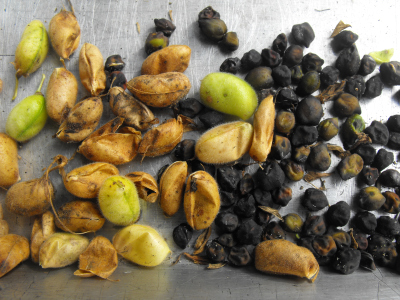 After
carefully
snipping butternuts off the vine and felling
towering sunflowers with a single blow, it was time to harvest our experimental
beans. First
came the garbanzos --- aren't they lovely? The only problem is
that what you see in this photo is nearly the entire harvest. I'm
not giving up on the variety, though, since a reader commented a few
months ago to let me know that the extremely confusing instructions on
the seed packet were really trying to tell me to plant
the garbanzos at the same time as peas. I planted them at the
frost free date instead, so I'll have to give the crop a more fair shot
next year.
After
carefully
snipping butternuts off the vine and felling
towering sunflowers with a single blow, it was time to harvest our experimental
beans. First
came the garbanzos --- aren't they lovely? The only problem is
that what you see in this photo is nearly the entire harvest. I'm
not giving up on the variety, though, since a reader commented a few
months ago to let me know that the extremely confusing instructions on
the seed packet were really trying to tell me to plant
the garbanzos at the same time as peas. I planted them at the
frost free date instead, so I'll have to give the crop a more fair shot
next year.
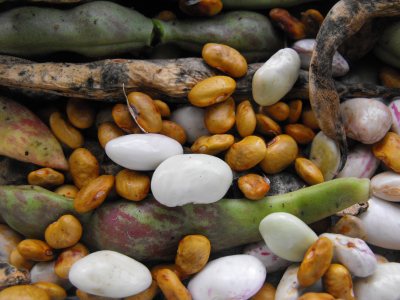 Next
stop "shelly beans", as folks around here like to call beans that you
grow for drying. The harvest in this bed was much better, despite
the fact that bean bugs ate the plants down to nubbins...then moved on
to my delightful Masai beans. I'm tempted to blame
the arrival of this new garden pest on the shelly beans, but I suspect
that it just took the beetles a few years to find us. Next year,
I'll add the Mexican Bean Beetle to my list of bad bugs to squash
weekly, and maybe all of our beans will do better.
Next
stop "shelly beans", as folks around here like to call beans that you
grow for drying. The harvest in this bed was much better, despite
the fact that bean bugs ate the plants down to nubbins...then moved on
to my delightful Masai beans. I'm tempted to blame
the arrival of this new garden pest on the shelly beans, but I suspect
that it just took the beetles a few years to find us. Next year,
I'll add the Mexican Bean Beetle to my list of bad bugs to squash
weekly, and maybe all of our beans will do better.
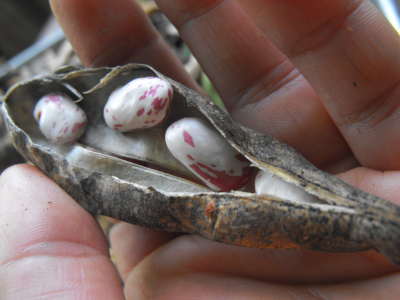 Although
the quantity of pods from the shelly bean bed was good, I discovered
that I should have picked the drying beans much sooner. Many
people leave beans for drying to harden on the plant, but our climate
is just too damp for that sort of harvest. By the time I picked
them, many of the older pods had begun to mold, and over half of the
beans were discolored. Next year, I'll harvest the beans when the
pods are still slightly green, then allow them to dry inside, out of the
weather.
Although
the quantity of pods from the shelly bean bed was good, I discovered
that I should have picked the drying beans much sooner. Many
people leave beans for drying to harden on the plant, but our climate
is just too damp for that sort of harvest. By the time I picked
them, many of the older pods had begun to mold, and over half of the
beans were discolored. Next year, I'll harvest the beans when the
pods are still slightly green, then allow them to dry inside, out of the
weather.
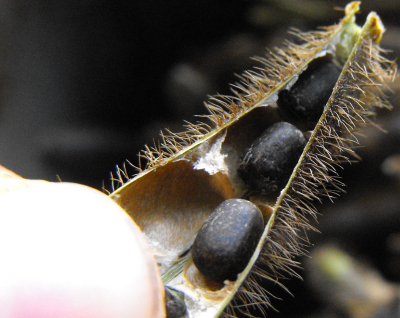 Finally,
I came to our Urd Beans (a variety of sprouting bean.) I thought
this bed was a goner after the deer nibbled it nearly down to the
ground...then repeated the maneuver a week later. But the Urd
Beans have a saving grace --- bean bugs don't like them. Despite
the name "Bean", Urd Beans are in an entirely different genus than Phaseolus
vulgaris (which
includes green beans and the green-bean-like shelling beans I
planted.) Instead, Urd Beans (Vigna
mungo) are in the
same genus as black-eyed peas, a group that seems to be of little
interest to our current crop pest.
Finally,
I came to our Urd Beans (a variety of sprouting bean.) I thought
this bed was a goner after the deer nibbled it nearly down to the
ground...then repeated the maneuver a week later. But the Urd
Beans have a saving grace --- bean bugs don't like them. Despite
the name "Bean", Urd Beans are in an entirely different genus than Phaseolus
vulgaris (which
includes green beans and the green-bean-like shelling beans I
planted.) Instead, Urd Beans (Vigna
mungo) are in the
same genus as black-eyed peas, a group that seems to be of little
interest to our current crop pest.
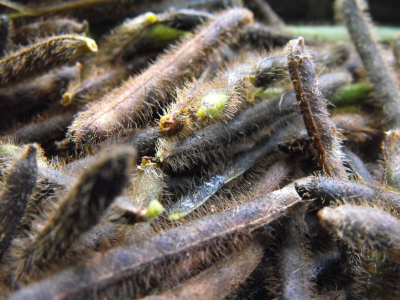 I
was also pleased to see that Urd Bean pods are hairy, a feature that
seems to repel moisture, keeping the seeds inside dry even after the
pods turn black. I harvested half of the pods, leaving the green
fruits on the vine to be picked at a later date. The only problem
I foresee with Urd Beans so far is their size --- shelling these little
guys by hand would take all day. (For a sense of scale, that's my
thumbnail on the left side of the first picture of urd beans.)
I'm hopeful, though, that after I let the pods dry for a week or two,
they'll be brittle enough that I can thresh them and then blow the
empty pods off the seeds.
I
was also pleased to see that Urd Bean pods are hairy, a feature that
seems to repel moisture, keeping the seeds inside dry even after the
pods turn black. I harvested half of the pods, leaving the green
fruits on the vine to be picked at a later date. The only problem
I foresee with Urd Beans so far is their size --- shelling these little
guys by hand would take all day. (For a sense of scale, that's my
thumbnail on the left side of the first picture of urd beans.)
I'm hopeful, though, that after I let the pods dry for a week or two,
they'll be brittle enough that I can thresh them and then blow the
empty pods off the seeds.
So, to sum up what
became far too long of a post --- garbanzos need to be planted in early
spring, shelly beans need to be harvested before the pods turn brown,
and Urd Beans are my new favorite experimental bean.
Want more in-depth information? Browse through our books.
Or explore more posts by date or by subject.
About us: Anna Hess and Mark Hamilton spent over a decade living self-sufficiently in the mountains of Virginia before moving north to start over from scratch in the foothills of Ohio. They've experimented with permaculture, no-till gardening, trailersteading, home-based microbusinesses and much more, writing about their adventures in both blogs and books.
Want to be notified when new comments are posted on this page? Click on the RSS button after you add a comment to subscribe to the comment feed, or simply check the box beside "email replies to me" while writing your comment.

The urd beans rather remind me of cowpeas, at least in terms of size - how lovely that the bean beetles leave them alone!
A note on Mexican bean beetles - make sure when you're picking them off that you check the underside of leaves and attempt to remove the bright yellow eggs - it's a pain, but it's a good way of making sure that you'll have fewer of the adults to deal with the next year (plus the larvae also eat leaves, so cutting them off early may save some of your beans this year). I try to scrape them off gently with my thumb nail. Of course, if others know of a better way to deal with this pest, that would be great! On the slightly bright side, they seem to come in waves: you'll have a few years with a lot of them and then hit one where you'll hardly see any. I would love to believe that this was because of my method of picking off both the adults and eggs . . . but I've already mentioned that I'm not as diligent as you are about bug removal, so there are probably some other forces at work as well, heh.
On the slightly bright side, they seem to come in waves: you'll have a few years with a lot of them and then hit one where you'll hardly see any. I would love to believe that this was because of my method of picking off both the adults and eggs . . . but I've already mentioned that I'm not as diligent as you are about bug removal, so there are probably some other forces at work as well, heh.
I'll let you know if I come up with any control measure that's better than hand-picking. I'm only good about hand-picking if I start with an insect as soon as it shows up. Once they're at deluge levels, like this year's bean beetles, I tend to stick my head in the sand and ignore them...
I wonder if weather has anything to do with population fluctuations from year to year? With a name like "Mexican bean beetle", I might suspect they like this crazy hot weather we're having....